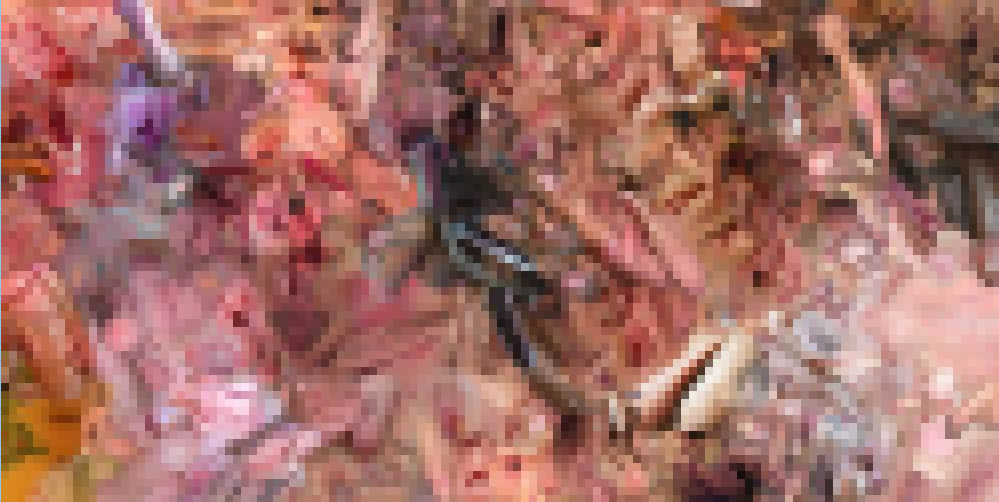ARCHIVE: PURE GENITALIA AESTHETIC
|
Image submission (click to enlarge): Pure Genitalia Aesthetic
|
Submission title: Pure Genitalia Aesthetic
Submitted by: Erica Lapadat-Janzen Participant’s field of work/interest: Web Artist Participant’s Image Description: "This image was derived from an image I created as part of a series of digital collages about the body and the things that we don't see generally in mass media because they are considered ugly, crass or embarrassing. This image originally was considered too graphic for social media and therefore had to be censored via pixelation." Translated and woven by Sophia Borowska. |
Translation to Weaving
Pointcarré weaving simulation (click to enlarge).
The image originally submitted was a censored version of an explicit collage. It was pixelated beyond direct recognition, but still communicating its content because of viewer-expectations of censored graphics. It does not take a huge leap of imagination to visualize what is being censored through pixilation when we see censored imagery. To translate this idea to weaving, I wanted to play with this viewer-expectation and expose how different it is in differing media. On the Internet, we know that pixelation hides censored content, but what would be the effect of an image censored on a textile surface? I asked Lapadat-Janzen to re-submit with the original, uncensored image so that it could be re-censored through weaving processes instead of digital ones. Translating an image to weaving always reduces the amount of one kind of information, such as colour numbers, resolution, and sharpness, while adding new layers of material information. It is particularly well suited to the censoring of images, because clarity and detail are easy to lose. The translation of the image was interesting for this piece, because I had to apply techniques normally harnessed to preserve as much information as possible, in this case to make sure the image was distorted beyond recognition.
- Sophia |
Technique and Process Notes
Structures (click to access structures - available to WDRG members only).
To replicate the pixelated effect and flatness of the censored image, I chose to use a system of weave structures called taqueté. Taqueté works with multiple wefts, in this case four colours: black, brown, pink, and cream. It is based on a plain-weave structure, making for an extremely tight cloth with very short floats and an even surface, if taqueté is used throughout. Colours are mixed on the surface to achieve a variety of tones. The overall texture resembles small squares, replicating the pixel-heavy aesthetic of the censored image.
- Sophia Original Dimensions: 999p x 502p Number of Picks: 800 Woven Dimensions: 20.5” x 12.5” Weaving Density: 64 ppi Threads Used: Warp is white 2/16 mercerized cotton. Wefts are black, brown, pink, and cream 2/8 cotton. |
Outcome Notes
Colour reduction for designing weaving (click to enlarge).
Using a taqueté system with such short floats somewhat washed out the colours. The white warp overpowered the colour-mixing effects I was trying to achieve. Perhaps the colours chosen at the outset were too similar to one another as well, because the colour areas became quite unclear and the image even more blurred than planned. I would have preferred to keep at least a hint of the censored content in the weaving, but nobody so far has been able to place the weaving’s content. The question still remains, is this because we are not used to seeing explicit material censored into textiles? People are more likely to see the design as abstracted flowers when on a woven surface. Maybe, once scanned and back online, the weaving will regain an association with censored content, and the viewer will see what is-but-isn’t there.
- Sophia |
Images of Final Woven Samples
FRONT (ABOVE), BACK (BELOW)







